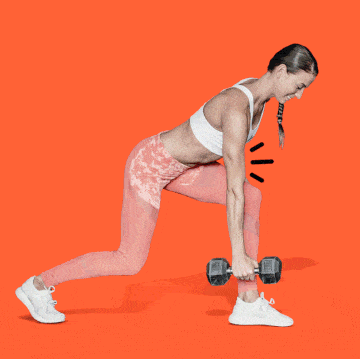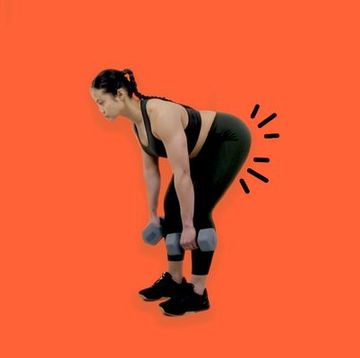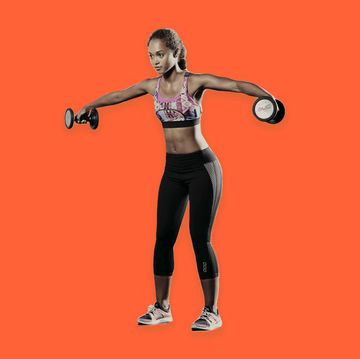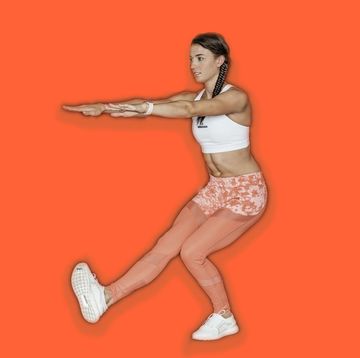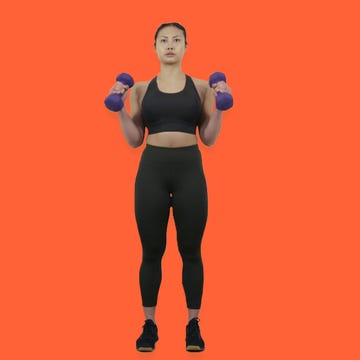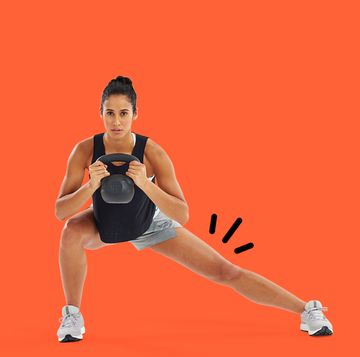Truth bomb: traditional squats are not the be-all and end-all when it comes to building lower-body strength. We know.
In fact, for those who need to even out muscular imbalances, build single-leg strength for running or really just aren’t fans of regular squats (no judgement, we’re all friends here), there may be a better option.
Enter the Bulgarian split squat, so named because it was once touted as the secret behind the Bulgarian Olympic weightlifting team’s success in the 70s and 80s. Coach Angel Spassov insisted the team ditched all other leg moves in favour of Bulgarian split squats and step-ups.
While he may have been overselling it a bit (other coaches have since said the team did do other exercises, obviously), Spassov wasn’t wrong when he extolled the virtues of the BSS.
Bulgarian split squat benefits
‘The Bulgarian split squat is a great exercise for strengthening your legs and your core, and increasing mobility,’ Charlotte Frazier, trainer and studio manager at F45 Croydon.
Not only does it target the glutes, quads and hammies – all the same muscles as a traditional squat – but also tests balance, requiring you to engage your core muscles to keep upright while balancing on one leg.
As for mobility, the height added by balancing your back leg on a step, bench, or the back of your couch, increased the depth you have to travel to complete the rep, making it tougher and increasing your range of motion.
Another point in the BSS’ favour? It’s a unilateral move, meaning it only works one leg at a time. That means less risk of your dominant side doing all the work, which may result in muscular imbalances. And trust us, when you first perform this move, you’ll know which side needs a bit of work.
What muscles do Bulgarian split squats work?
As we mentioned above, the Bulgarian split squat targets:
- Quadriceps (front of thighs)
- Hamstrings (back of thighs)
- Glutes (bum)
- Core
How to do Bulgarian split squats
- Start by standing with your back to a bench (or step, chair, coffee table or couch – just make sure it’s sturdy). Shift your weight to one leg and raise the other behind you to lift it up onto the bench.
- Keeping your hips square, back straight and core tight, lean your torso forward slightly and sink down until your elevated knee almost touches the floor. Make sure you keep your glutes engaged throughout, says Frazier – ‘imagine you are holding a £20 note between your cheeks.’
- To come up, simply reverse the move, pushing through your front heel to return the start. Repeat 10-12 times before switching to the other leg, and do at least 3 sets on each leg, Frazier suggests.
To focus on your glutes, go for a wider stance. To focus on your quads, bring your front foot closer to the bench.
Level-up your Bulgarian split squats
You might find a bodyweight version of this move challenging enough, but when you’re ready to up the ante, try it with a dumbbell in each hand or a barbell resting on your shoulders.
If you don’t have access to weights, you can make the move more challenging by increasing the time under tension, Frazier says.
‘Try slowing down your reps, for example, taking 5 seconds to lower down, or pulsing 10 times before coming to stand,’ she says. ‘You can also add a calf raise at the top of the move [come up onto the toes of your front foot]. This will improve your balance and stability, not to mention working those calves too. Bonus.
Avoid if: If you suffer from ankle or knee instability. ‘If it hurts at all, always stop and seek the advice of your doctor,’ Frazier says.
Bulgarian split squat form mistakes
1. You’re rounding your back.
This is a common mistake, Frazier says. ‘Always keep your chest up during the move and look forward so you don’t arch your neck.’
2. You’re wobbling around
Try adjusting your stance, Frazier suggests. ‘Standing too close or too far away from the bench can make you unstable and add pressure to your joints, rather than your muscles.’ Make sure you get comfortable and build stability in the move before you try target glutes or quads, as suggested above.
3. Your front knee is going over your toes
This places unnecessary pressure on your knee – always make sure you can see your toes to stay safe.
Cut through the noise and get practical, expert advice, home workouts, easy nutrition and more direct to your inbox. Sign up to the WOMEN'S HEALTH NEWSLETTER



